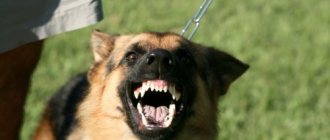Almost all owners want to have a protective dog in the house, which will be able to warn them by barking if strangers approach the door. How is it permissible to train a dog to bark?
You will need
- A vacuum cleaner, a hairdryer, a favorite toy, a slice of something tasty, a musical instrument, a rather brave friend, overalls, a dog handler friend.
Instructions
1. Dogs usually react sharply to outside noise: a vacuum cleaner, a hairdryer. When you turn on these loud devices, you need to give the dog the “Voice” command. Later, the dog will respond to the command on its own. 2. Try “barking” at the dog and causing a response from it. 3. Clap. As usual, clapping your hands (a loud sound), as well as whistling and stomping, causes dogs to growl or bark. 4. Take the toy away from the dog and do not give it back until it starts barking. Show her something tasty or her favorite ball, lift it up and don’t give it back until she, having lost patience, barks. Then give the command and praise for its execution, give back what you were hiding. It is necessary to give a command in time when the dog has already opened its mouth, but has not yet barked. With repeated repetitions, the dog will soon understand what you want from him. Reward your dog for following a command with some kind of treat. 5. If you want to teach a dog to bark at strangers, persuade your friend to imitate an attack. In this case, the dog realizes that it needs to protect what is dear. Don't forget that to complete this step you need special clothing! 6. Try to grab the dog's nose with your fingers or pretend that you want to flick it on the forehead. 7. Many dogs react to certain sounds of musical instruments, some dogs howl, others bark. Such musical instruments include a children's pipe, flute, harmonica, and various whistles. 8. Consult dog handlers. They are experts in this field and will probably be able to find the right approach for your pet. 9. You can also resort to the help of the person involved. This is the person with whose help the dog learns to bark at strangers. The helper angers the dog using various methods and thereby induces the desired behavior.
Every trainer knows that a dog, just like a person, requires a personal approach. All breeds have their own characteristics, and not every dog can be trained at a distance. But it is still necessary to train an animal, though so that the dog is controllable, and you can be sure that it will not violate your command or cause inconvenience to other people. Guard dogs require special attention and work from the handler.
You will need
- – protected item;
- - rope.
Instructions
1. Allowed to teach dog protect a person, a house or primitive things you left behind. The latter is extremely beneficial in everyday life. Before teaching dog guard, remember that training is a system of rules and rewards. If you decide to train dog , then you need to do this systematically, and not when you have time and desire. Start training your puppy when he is 3-5 months old. 2. Teach her not to trust unknown people. Ask someone you know who the dog doesn't know to help. Make sure that the dog is peaceful and in excellent health; on the contrary, it may begin to become “wilful.” 3. Place in front of the animal the thing that he needs to protect. The dog must be on a leash, but in such a way that it can reach the object and move freely. Command: “Guard!” 4. Your friend should pass the dog at a short distance at first. Watch the animal's reaction. If she's too crazy, sit her down and calm her down. dog . Command again: “Guard!” 5. The next time, your friend should try to pick up the thing that the dog is guarding, and at this time you repeat the command for the dog again. If necessary, do this several times in a row. 6. The dog must understand what you want from it. And when she starts guarding the thing, your friend should run away, thereby showing that the dog has mastered its task. Praise and encourage your dog so that he knows that he did everything positively. There are situations when a dog can react to a third party, but refuses to guard the thing. In this case, try modifying the task. 7. Tie a rope approximately one meter long to the protected object. And after the dog rushes barking at your assistant, he must pull the rope so that the object moves. Not powerful. A moving object usually attracts the dog's attention. If your dog makes an attempt to stop this thing, then you must encourage and encourage him until he finally gets the thing back. 8. Repeat this maneuver several times until you achieve a result where the dog will immediately growl at the person who just reaches out to the thing he is guarding. Don’t forget to praise your dog. Your approval is very important to him. Video on the topic
It is advisable to begin training any pet at puppyhood. It is during this period that the foundations of the relationship with the dog are laid. You can teach your dog commands independently, but when learning the first skill, it’s best to start working under the supervision of a dog trainer.
How to teach a dog the “Voice” command
Sometimes it is necessary for the dog to start barking at your command. The voice is practiced during the game, as are many commands. When playing with a pet, say, with a ball, periodically say the command “Voice”, wait for him to bark for no reason and immediately praise the dog exuberantly and happily, repeating “Voice, voice!”, Give a treat (a small slice of cheese, dried liver).
Repeat the process until the command is fully established. At the same time, it is important to change the toy and the environment of excitement so that the dog does not associate praise from you with the game, but sees a direct connection between your command, barking and reward.
When to start training
The time to start training a pet depends on the breed and temperament characteristics. Over time, puppies of initially aggressive breeds themselves begin to demonstrate protective qualities, so their manifestations of anger should not be developed, but controlled and corrected.
Most dog trainers believe that teaching a puppy to bark at strangers before 6 months does not make sense. The dog may not be able to cope with aggression and become not only angry, but also uncontrollable. An example of such deviation is submission only to the owner and aggression towards other family members.
If the main goal is to overcome the “puppy delight” with which the dog treats everyone who shows attention to him, you can wait until 9-12 months and then start training. As your pet gets older, it will likely become more reserved and will be much easier to train.
How to teach your dog the “Sit” command
Classic training for this team looks like this. A treat is taken in the hand, shown to the pet, but not given. The hand with the treat is raised above the dog’s head, the command “Sit” is given, and at the same time another hand presses on the dog’s sacrum, forcing the dog to sit. As soon as she sits down, the treat is immediately given, followed by crazy praise and a repeat of the command.
In real time, dog handlers choose to use a non-contact option for teaching this command. That is, no pressure is applied to the sacrum; at the same time as the command “Sit” is pronounced, the hand with the treat is raised above the head and moved slightly forward in such a way that the dog is obliged to throw it back without taking his eyes off the treat. In this position, the dog will definitely sit, which he will do. Here you need to give a treat and praise your pet.
The relationship between dog and owner comes first
A dog must be raised from childhood, regardless of the breed and purpose of the establishment. The owner is a priori a leader for her, and all attempts to dominate must be stopped. Discipline and unquestioning execution of the owner’s commands are the basic principles in building a relationship between him and the pet.
But this does not at all exclude love for the animal and its manifestations on the part of all family members, both adults and children. The dog feels love and care, and is ready to become a loyal friend and protector of a person. With close contact between the animal and the owner, learning commands is much more effective. The dog is instinctively ready to protect his friend, whose task is to teach the pet to distinguish between friends and foes.
How to teach your dog the “Down” command
The command “Lie down” is learned with a pet using a similar method. The dog is shown a treat held in the left hand, after which this hand is lowered to the floor, at the same time the command “Lie down” is given, and the right hand presses on the dog’s withers, thereby forcing it to lie down. As soon as the desired position is achieved, the treat is immediately given and praise follows, interspersed with the repetition of the learned command “Lie down”.
Beginners (and not only) in the process of this training often make the mistake of allowing the dog to take what desired lying position. It is impossible to allow the pet to fall on its side when lying down; a clear position is needed: paws forward, muzzle above the paws. Correct the dog as many times as necessary, and give treats only for positive performance.
It is important to know
It is necessary to repeat the training of each command 4-5 times in one approach; during each day, for consolidation, it is necessary to do about 3-4 approaches. It is necessary to start teaching any commands before feeding, so that praise with a treat has a powerful positive effect. Learning a new command begins only after the completion of the previous one.
In the same way, you can teach an adult dog commands. But in this case, it is absolutely expected that a lot of time, patience and perseverance will be required. If the pet has obvious behavioral disorders, it is advisable to coordinate any training with a dog trainer. In total, it takes 3-5 days to teach a dog commands, depending on the breed, age of the pet and your persistence.
Video on the topic
Every dog owner who deeply loves his pet is ready to talk for hours about how his animal is the most intelligent in the world. Dogs are truly wise and very trainable. Exceptionally zealous owners manage to not only teach their four-legged friend the simplest commands, but also ensure that the animal speaks.
Instructions
1. If the dog is not silent by nature, then there is a chance to teach him to pronounce the simplest words. It is easier for anyone to train dogs by exchanging a correctly executed command for some kind of treat. Stock up on food that your dog loves the most and start training. Show the dog a treat and ask the dog to say “mama.” Repeat many times in a row: “Mom, mom, mom...”, while showing the dog a secret treat. After he tries to repeat the word, feed him. 2. If the dog has learned to pronounce the word “mom” clearly, then you can complicate the task and make sure that this word serves as the result of the question. Ask the dog to say a word, and then ask a question, for example, “Who is our fairest?” As at the very beginning of training, continue asking the question until the dog gets used to answering it. 3. Having mastered the word “mother”, the dog, more likely than anyone, will be able to pronounce it and vice versa. When a dog is hungry and begs to be fed, beg it to say “Am-am!” – sooner or later the dog will get used to it. 4. Dogs are the best at imitating the sounds [a], [p], [u], [m] and [g]. To train your dog, be diligent in choosing short words containing exactly these sounds. Words must be pronounced clearly and loudly, while the dog must look at you and see how you articulate. 5. Not all dogs can imitate sounds; this is a gift inherent in nature. But this does not prevent many animals from conducting dialogues with the owner in their own language. Easily talk to the dog like a person, ask him how he is doing, etc. Most likely, each animal will respond to you with long canine remarks in a different way. If you do this continuously, you can notice that depending on the mood, the dog barks with different intonations every time. 6. Train your dog to listen to the human voice. Many dogs eagerly listen to songs - sing to the dog yourself or turn on music. The dog may start howling to her rhythm. Next, you can teach your dog to sing on command. Tell her “Let’s sing!” and sing along with her. 7. A smart dog can be trained to communicate with you without the help of a voice. From childhood, show him objects that somehow relate to his life, tell him what they are called. Train your dog to point to them when he wants something. Let him bring you the ball himself when he wants to play or a leash when it’s time to go for a walk. Video on the topic
Dogs have long been used as hunting assistants. But a wise dog can not only help chase an animal or bring a bird. A trained dog is also necessary for “silent hunting”. If you regularly go to the forest to pick mushrooms in the summer and autumn, it makes sense to train your pet to find them.
The sequence of teaching a dog to distrust strangers
We train all dogs to distrust strangers in stages according to the following scheme:
- Stage one - we train the dog according to the LIROS course (leadership-role training of the dog) in order to create a working team (surrogate pack), social ranks and social relationships (senior-junior);
As a result of such training, the dog becomes obedient, since it is subordinate, the fulfillment of its desires is placed under stimulus control (controlled by the owner’s signals), the basis for conflicts is eliminated and the owner (his behavior, requirements) becomes clear to the dog and it is maximally ready for further training.
- Additionally, the dog is protected from communicating with strangers - none of your friends or acquaintances are allowed to pet the dog (“get your own and pet it for good health”), since your dog has no “friends”;
The dog is accustomed to being in a cage at home and in an enclosure in the yard. She doesn't feel stressed when she's there. And when friends or acquaintances come to visit, the dog goes to its place to rest (in a cage or enclosure).
- Stage two - we train the dog to protect our “resources”: food, territory, household items, and also ensure the personal safety of the owner;
- Additionally, we train the dog not to react to strangers if they do not “encroach” on the resources of our “pack” (do not show aggression towards us, do not attack, do not try to steal our things).
Now you understand that instead of the question - “How to wean a dog to trust strangers?” The following question should be asked: “How to teach a dog not to trust strangers?” And we can give a specific answer to this in a video of a specially designed training program.
Jagdterrier West during training to protect the handler and backpack
How to train a dog to hunt mushrooms
Teaching a dog to look for a certain type of mushroom is not that difficult. For example, in Europe dogs are deliberately trained to search for truffles. The cost of renting a smart animal reaches several hundred euros per day. Using this methodology, you can make your dog an assistant in your hobby. To begin, start adding a small amount of mushroom broth, obtained from one type of mushroom, to your dog’s usual food. Dogs have a great sense of smell, and one or two drops will be enough for the animal to smell the smell and mentally connect the smell of mushrooms and food. Train your dog to eat only after your command, on the contrary, you risk that the dog will not only detect the mushroom, but also will taste it first. You will lose your prey, and the dog may have an upset stomach. After this, you can begin the second stage of training. Drop the same mushroom broth onto your dog's favorite toy, hide it and give the dog the command to start searching. After the animal has managed to find its favorite ball or rope, praise it and treat it with a treat. Finally, it’s time to test the dog in practice. Take a few mushrooms and hide them in an area that is familiar to your dog (this could be your summer cottage or a yard where you often walk). Command the dog to start searching and do not forget to praise the animal after each discovery. If the dog has successfully completed its task, it is allowed to go into the forest and find mushrooms there.
The dog doesn't bark?
Although dogs have a rich and varied body language, barking is still their form of expression and communication most easily identified by humans. Therefore, a puppy or adult dog that never barks or that suddenly stops barking is often a cause for concern. Although it is true that some pathologies, such as laryngitis , can cause aphonia in dogs.
There are also factors inherent in their nature and some bad habits that can damage their vocal cords and change their vocal output.
Have you noticed that your dog has stopped barking and are worried that he might be sick? Well, don't hesitate to consult your veterinarian to rule out possible pathological causes. And if you want to know more about the reasons that may explain why your dog never barks, we recommend that you continue reading this post.
Underwater rocks
All mushrooms smell different. You can train your dog to look for boletus mushrooms, honey mushrooms or chanterelles, but raising a generalist dog is very difficult. The animal must be wise, have a special gift, and a patient and experienced instructor needs to work with it. If you want to teach a dog to look for different types of mushrooms, then you need to do this by teaching the dog one by one to associate each type with food and look for it. You should also remember that that the dog will not look for mushrooms with a clean stem and elastic cap, suitable for consumption, but for everything that smells like mushrooms. The animal will lead you to recently cut stumps and half-rotten old fruiting bodies. Trying to please the owner, the dog can run away over significant distances in search of its prey, and you will have to look not only for mushrooms, but also for your animal. Teach your pet to either signal your discovery by barking, or keep your pet on a leash so that it doesn’t get lost. Video on the topic
be taught “ Voice command , regardless of whether it likes to bark or not. The main thing is to develop in her a connection between her barking and some type of reward. Several such lessons, and the dog will form a stable reflex to give voice on command .
Instructions
1. Dog training begins with the goal of provoking it to bark. Let's say you can tease with a tasty treat. If a dog is hungry, it begins to bark indignantly. At this time, the command “ Voice ” is pronounced and a treat is given. 2. It is allowed to tease a dog with a toy, say, a fetch item. They are waved over the dogs' heads, but not thrown. The dog starts jumping and barking. The command “ Voice ” is pronounced. 3. If the dog still does not want to bark for a long time, then it is allowed to let it grab the object with its teeth, but not give it back, but start to bully it. When the animal gets completely angry, then pull the object out of its mouth and raise it above the dog. For further barking, give the command “ Voice ” and reward the dog with a treat. 4. During the day, the dog barks from time to time at the sound of a knock on the door, at something that alarms it. The main thing is to wait for the moment and give the command in a timely manner. And of course, don’t forget to praise your pet and give him a treat. 5. It is allowed to get ready for a walk in front of the dog, go out the door and slightly close it in front of the dog’s nose, leaving a gap. And then call your pet to your place. Barking will follow immediately. Next, the command “ Voice ” is pronounced and a treat is given. 6. Teaching a dog commands is not difficult. The main thing is to be patient and clearly distinguish the line of what is allowed. It is impossible to teach a dog to bark at passers-by, especially children. Video on the topic
A wise and well-mannered dog is a perfect partner for a person. In order for your pet to graduate from dog school with honors, you need to start his training from the first day when a puppy appeared in your home.
Instructions
1. Before anyone else, the dog must learn “everyday” commands: respond to its name, know where to go to the toilet, understand the commands “Place” and “Quiet”. It is easier to train to respond to a name when feeding: place the puppy’s bowl on the floor and call the animal several times. After this, in between feedings, call the baby and treat him to something tasty, after which you can replace the treat with affection or play. This way the dog will quickly get used to its name. Toilet training is the most troublesome stage. First, you can teach the puppy to go to the litter box, after which, after vaccination, you can move to the street. Praise your pet for every puddle and pile made in the right place. Team "Place". Take the baby to his bedding, hold him gently, repeating “Place,” and treat him with a treat. If the puppy sits quietly for a while, praise him loudly. Slowly begin to move away, ensuring that your pet remains in place. The next stage is to train the dog to go to the bedding itself at the first request of the owner. The “Quiet” command is necessary in order to prevent unnecessary noise. If your pet barks, sternly command him “Quiet!” and carefully close your mouth with your hand. Praise. Little by little you must achieve that when you say “Quiet!” The dog immediately becomes silent and does not attempt to resume barking. 2. The further block of commands must be learned on the street. The main command is “Come to me!” Your dog must fulfill it perfectly - the safety of the people around him and the animal itself depends on it. Start training at home. Periodically call the puppy with the word “Come to me,” give him a treat, and play with him. This command should be associated with the glorious, the dog should be happy to approach the owner. After this, the same should be repeated on the street. As a result, the dog should come to you when called. Further command “Fu!” You should also start practicing it from your apartment. As soon as you notice that the puppy is trying to take something illegal into its mouth, abruptly shout “Ugh!” You can also spank the stubborn person with a newspaper - a loud bang will be unpleasant for the baby. But no more! Remember that you cannot hit a dog with your hand or with a leash! By cruelty you will never achieve trust and truthful obedience. 3. You should also teach the dog the commands “Sit”, “Lie down”, “Stand”, “Nearby”. It is best to do this after mastering special literature or under the supervision of a dog handler. Take your pet to the local kennel club or join a dog training group. Training a dog together with other relatives has a beneficial effect on its psyche. If something doesn’t work out, then you can always train individually. In order to get a well-mannered dog, you need to go through a general training course (UCD); if you are the owner of a huge dog, then dog handlers advise after the OKD to take a defensive training course (DTC). There your dog will be trained to protect the owner and his property. 4. You can go further and master agility with your dog (the dog quickly overcomes obstacles under the command of the owner), canicross (a person and a dog run together), skijoring (a dog and a person run a certain distance on skis) and much, much more! The most important thing is that joint training brings pleasure to you and your pet! Helpful Tip When training your dog, be strict, but not cruel. Firmness and patience are your best helpers. Do not skimp on praise - if the dog correctly does what is required of it, treat it with a treat or reward it with affection. Before starting training, read special literature. The more you understand the issues of training, the easier it will be to achieve what you want from your pet. When training your dog, use the recommendations of experienced dog breeders and dog handlers. This will help you avoid mistakes, and you will achieve what you want faster.










